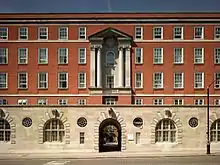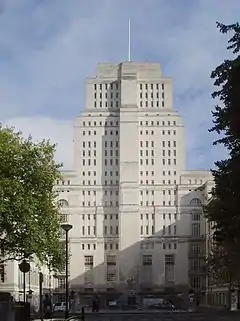Imperial College London
Imperial College London (legally Imperial College of Science, Technology and Medicine)[7] is a public research university in London. Imperial grew out of Prince Albert's vision of an area for culture, including the Royal Albert Hall, Imperial Institute, numerous museums, and the Royal Colleges that would go on to form the college.[8][9] In 1907, Imperial College was established by Royal Charter, merging the Royal College of Science, Royal School of Mines, and City and Guilds College.[10] In 1988, the Imperial College School of Medicine was formed by combining with St Mary's Hospital Medical School. In 2004, Queen Elizabeth II opened the Imperial College Business School.
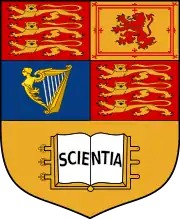 | |||||||||||||||||||||||
| Motto | Latin: Scientia imperii decus et tutamen[note 1] | ||||||||||||||||||||||
|---|---|---|---|---|---|---|---|---|---|---|---|---|---|---|---|---|---|---|---|---|---|---|---|
Motto in English | Scientific knowledge, the crowning glory and the safeguard of the empire | ||||||||||||||||||||||
| Type | Public research university | ||||||||||||||||||||||
| Established | 1907 by royal charter[2] 114 years ago | ||||||||||||||||||||||
| Endowment | £176.0 million (as of 31 July 2020)[3] | ||||||||||||||||||||||
| Budget | £1.033 billion (excluding pension provisions) (2019/20)[3] | ||||||||||||||||||||||
| President | Alice Gast | ||||||||||||||||||||||
| Provost | Ian Walmsley | ||||||||||||||||||||||
| Visitor | Jacob Rees-Mogg (as Lord President of the Council ex officio) | ||||||||||||||||||||||
Academic staff | 4,390 (2018/19)[4] | ||||||||||||||||||||||
Administrative staff | 4,075 (2016/17)[4] | ||||||||||||||||||||||
| Students | 19,115 (2018/19)[5] | ||||||||||||||||||||||
| Undergraduates | 9,985 (2018/19)[5] | ||||||||||||||||||||||
| Postgraduates | 9,130 (2018/19)[5] | ||||||||||||||||||||||
| Location | London , United Kingdom | ||||||||||||||||||||||
| Scarf | |||||||||||||||||||||||
| Colours | Imperial blue[6] | ||||||||||||||||||||||
| Affiliations | |||||||||||||||||||||||
| Website | imperial | ||||||||||||||||||||||
The college focuses exclusively on science, technology, medicine and business. The college's main campus is located in South Kensington, and it has an innovation campus in White City, a research field station at Silwood Park, and teaching hospitals throughout London. The college was a member of the University of London from 1908, becoming independent on its centenary in 2007.[11][12] Imperial has an international community, with more than 59% of students from outside the UK and 140 countries represented on campus.[13][14] Student, staff, and researcher affiliations include 14 Nobel laureates, 3 Fields Medalists, 2 Breakthrough Prize winners, 1 Turing Award winner, 74 Fellows of the Royal Society, 87 Fellows of the Royal Academy of Engineering, and 85 Fellows of the Academy of Medical Sciences.[15]
History
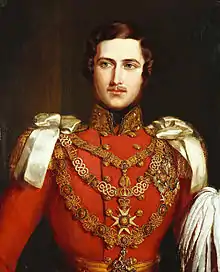
19th century
The earliest college that led to the formation of Imperial was the Royal College of Chemistry, founded in 1845, with the support of Prince Albert and parliament.[9] This was merged in 1853 into what became known as the Royal School of Mines.[16] The medical school has roots in many different schools across London, the oldest of which being Charing Cross Hospital Medical School which can be traced back to 1823, followed by teaching starting at Westminster Hospital in 1834, and St Mary's Hospital in 1851.[17][18][19]
In 1851, the Great Exhibition was organised as an exhibition of culture and industry by Henry Cole and by Prince Albert, husband of the reigning monarch of the United Kingdom, Queen Victoria. An enormously popular and financial success, proceeds from the Great Exhibition were designated to develop an area for cultural and scientific advancement in South Kensington.[20] Within the next 6 years the Victoria and Albert Museum and Science Museum had opened, joined by new facilities in 1871 for the Royal College of Chemistry and in 1881 for the Royal School of Mines, the opening of the Natural History Museum in 1881, and in 1888 the Imperial Institute.[21]

In 1881, the Normal School of Science was established in South Kensington under the leadership of Thomas Huxley, taking over responsibility for the teaching of the natural sciences and agriculture from the Royal School of Mines.[22] The school was renamed the Royal College of Science by royal consent in 1890.[23] The Central Institution of the City and Guilds of London Institute, was opened as a technical education school on Exhibition Road by the Prince of Wales in early 1885.[10]
20th century
At the start of the 20th century, there was a concern that Britain was falling behind Germany in scientific and technical education. A departmental committee was set up at the Board of Education in 1904, to look into the future of the Royal College of Science. A report released in 1906 called for the establishment of an institution unifying the Royal College of Science and the Royal School of Mines, as well as – if an agreement could be reached with the City and Guilds of London Institute – their Central Technical College.[24][25]
On 8 July 1907, King Edward VII granted a Royal Charter establishing the Imperial College of Science and Technology. This incorporated the Royal School of Mines and the Royal College of Science. It also made provisions for the City and Guilds College to join once conditions regarding its governance were met, as well as for Imperial to become a college of the University of London.[26] The college joined the University of London on 22 July 1908, with the City and Guilds College joining in 1910.[10][11] The main campus of Imperial College was constructed beside the buildings of the Imperial Institute, the new building for the Royal College of Science having opened across from it in 1906, and the foundation stone for the Royal School of Mines building being laid by King Edward VII in July 1909.[24]
As students at Imperial had to study separately for London degrees, in January 1919, students and alumni voted for a petition to make Imperial a university with its own degree awarding powers, independent of the University of London.[27][28] In response, the University of London changed its regulations in 1925 so that the courses taught only at Imperial would be examined by the university, enabling students to gain a BSc.[29]
In October 1945, King George VI and Queen Elizabeth visited Imperial to commemorate the centenary of the Royal College of Chemistry, which was the oldest of the institutions that united to form Imperial College. "Commemoration Day", named after this visit, is held every October as the university's main graduation ceremony.[30][31] The college also acquired a biology field station at Silwood Park near Ascot, Berkshire in 1947[32]
Following the second world war, there was again concern that Britain was falling behind in science – this time to the United States. The Percy Report of 1945 and Barlow Committee in 1946 called for a "British MIT"-equivalent, backed by influential scientists as politicians of the time, including Lord Cherwell, Sir Lawrence Bragg and Sir Edward Appleton.[33][34] The University Grants Committee strongly opposed however,[33] and so a compromise was reached in 1953, where Imperial would remain within the university, but double in size over the next ten years.[35][36] The expansion led to a number of new buildings being erected. These included the Hill building in 1957 and the Physics building in 1960, and the completion of the East Quadrangle, built in four stages between 1959 and 1965. The building work also meant the demolition of the City and Guilds College building in 1962–63, and the Imperial Institute's building by 1967.[37] Opposition from the Royal Fine Arts Commission and others meant that Queen's Tower was retained, with work carried out between 1966 and 1968 to make it free standing.[38] New laboratories for biochemistry, established with the support of a £350,000 grant from the Wolfson Foundation, were opened by the Queen in 1965.[39][40]
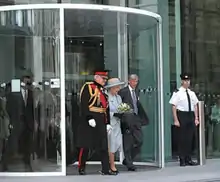
In 1988, Imperial merged with St Mary's Hospital Medical School under the Imperial College Act 1988. Amendments to the royal charter changed the formal name of the institution to The Imperial College of Science, Technology and Medicine and made St Mary's a constituent college.[41] This was followed by mergers with the National Heart and Lung Institute in 1995 and the Charing Cross and Westminster Medical School, Royal Postgraduate Medical School and the Institute of Obstetrics and Gynaecology in 1997, with the Imperial College Act 1997 formally establishing the Imperial College School of Medicine.[42]
21st century
In 2003, Imperial was granted degree-awarding powers in its own right by the Privy Council. In 2004, the Imperial College Business School and a new main entrance on Exhibition Road were opened by Queen Elizabeth II.[43][44] The UK Energy Research Centre was also established in 2004 and opened its headquarters at Imperial. On 9 December 2005, Imperial announced that it would commence negotiations to secede from the University of London.[45] Imperial became fully independent of the University of London in July 2007.[12][46][47]
In April 2011, Imperial and King's College London joined the UK Centre for Medical Research and Innovation as partners with a commitment of £40 million each to the project. The centre was later renamed the Francis Crick Institute and opened on 9 November 2016. It is the largest single biomedical laboratory in Europe. The college began moving into the new White City campus in 2016, with the launching of the Innovation Hub.[48] This was followed by the opening of the Molecular Sciences Research Hub for the Department of Chemistry, officially opened by Mayor of London, Sadiq Khan in 2019.[49] The White City campus also includes another biomedical centre funded by a £40 million donation by alumnus Sir Michael Uren.[50]
Campuses
.jpg.webp)
South Kensington
Imperial's main campus is based in South Kensington. Notable buildings include the Royal College of Science, the Royal School of Mines, the Business School, and the Queen's Tower, which sits is at the heart of the campus. As part of Albertopolis, a cultural centre based on the vision of Prince Albert, the campus is surrounded by many of London's most popular cultural attractions including the Royal Albert Hall and Kensington Palace, museums including the Natural History Museum, Victoria and Albert Museum, and Science Museum, and institutions such as the Royal College of Art, the Royal College of Music, and the National Art Library.[51][52]
The campus has many restaurants and cafés run by the college,[53] and contains much of the student accommodation, including the Prince's Garden Halls, and Beit Hall, home to the college union, which runs student pubs, a nightclub, and a cinema on site. To the north lie Kensington Gardens and Hyde Park, which are within easy walking distance from the college, and provide green spaces and sports facilities which many of the student clubs take advantage of.[54]

White City
A second major campus has started opening in White City, to the west of the main campus, providing an innovation hub for the college, including research facilities and commercialisation space, as well as postgraduate accommodation.[55] The chemistry department moved much of its research to the new Molecular Sciences Research Hub on the campus in 2018,[49] with further departments and industry partners moving to the campus and surrounding area over the coming years.[56] The campus is also home to the Invention Rooms, a college hackerspace and community outreach centre.[57] The area hosts a number of biotechnology companies in the Imperial White City Incubator and the OpenCell biotech hub.[58][59]
Silwood Park
Silwood Park is a postgraduate campus of Imperial located in the village of Sunninghill near Ascot in Berkshire. The Silwood Park campus includes a centre for research and teaching in ecology, evolution, and conservation set in 100 ha of parkland where ecological field experiments are conducted, and contains student halls for students studying for a degree on the site.
Hospitals
Imperial has teaching hospitals across London which are used by the School of Medicine for undergraduate clinical teaching and medical research. All are based around college-affiliated hospitals, and also provide catering and sport facilities. College libraries are located on each campus, including the Fleming library at St Mary's.[60]
Organisation and administration
Faculties and departments
Imperial is organised through a network of faculties and departments:[61]
- Aeronautical Engineering
- Bioengineering
- Chemical Engineering
- Civil & Environmental Engineering
- Computing
- Dyson School of Design Engineering
- Earth Science & Engineering
- Electrical & Electronic Engineering
- Materials
- Mechanical Engineering
- Centre for Environmental Policy
- Chemistry
- Life Sciences
- Mathematics
- Physics
- Brain Sciences
- Immunology and Inflammation
- Infectious Disease
- Metabolism, Digestion and Reproduction
- Surgery and Cancer
- Institute of Clinical Sciences
- National Heart and Lung Institute
- School of Public Health
Imperial College Business School
- Finance
- Innovation & Entrepreneurship
- Management
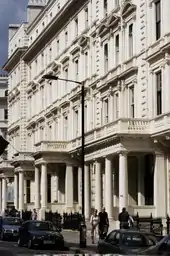
Global institutes
Imperial hosts global centres to promote inter-disciplinary work:
- Energy Futures Laboratory
- Gandhi Centre for Inclusive Innovation
- Grantham Institute for Climate Change
- Institute for Security Science & Technology
- Centre for Health Economics & Policy Innovation
- Brevan Howard Centre for Financial Analysis & Technology
- Global Entrepreneurship & Development Index
- Data Science Institute
- Institute for Molecular Science and Engineering
- Francis Crick Institute
Academic centres
Imperial College also houses two academic centres, formerly the Department of Humanities, offering teaching to undergraduate and postgraduate students in modern and historical languages, arts and humanities subjects, social sciences and other subjects which fall outside of the standard remit of science, technology and medicine. The aim of these centres is to provide training in study skills, such as the acquisition of English language proficiency, but also to encourage innovatory and interdisciplinary approaches to science, technology and medicine, which might make use of study of the arts, humanities, languages and social sciences. The academic centres are the:
- Centre for Academic English
- Centre for Languages, Culture and Communication
The Centre for Languages, Culture and Communication also operates as Imperial College London's adult education centre, offering evening class courses in the arts, humanities, languages and sciences.[62]
Governance

The highest academic official of Imperial College London is the President, formerly known as the Rector. The President is the chief executive, elected by the Council of the college and Chairman of the Senate.[63] The position has been held by Alice Gast, an American chemical engineer, since September 2014.[64]
In 2012, the additional post of Provost was created. James Stirling became the first Provost of Imperial College London in August 2013.[65] He was succeeded as Provost by Ian Walmsley in September 2018.
The council is the governing body of Imperial, it consists of 23 members including the Chairman, the President, the Provost, the President of the Imperial College Union, 4 members of senior staff, and between 9 and 13 lay members who are not employees of Imperial. The current Chair is Sir Philip Dilley.[66]
Finances and endowment

In 2017/18, Imperial had a consolidated income of £1,033.0 million. It has the seventh largest endowment of any university in the United Kingdom, and the second largest of the universities in London.[67] The college's endowment is sub-divided into three distinct portfolios:
- Unitised Scheme – a unit trust vehicle for the college, Faculties and Departments to invest endowments and unfettered income to produce returns for the long term
- Non-Core Property – a portfolio containing around 120 operational and developmental properties which the college has determined are not core to the academic mission
- Strategic Asset Investments – containing the college's shareholding in Imperial Innovations and other restricted equity holdings.[67]
Affiliations and partnerships
Imperial is a member of the Association of Commonwealth Universities, European University Association, Global Alliance of Technological Universities, League of European Research Universities and the Russell Group. It is a founding member of the Imperial College academic health sciences centre, the Francis Crick Institute and MedCity.
Imperial is a long-term partner of the Massachusetts Institute of Technology, with the first formal large-scale collaboration agreement dating back to 1944 as part of the World War II scientific effort.[68] The two institutions still share a strong bond with exchange programs for their students and academic staff.[69][70]
Academic profile
Rankings
| National rankings | |
|---|---|
| Complete (2021)[71] | 5 |
| Guardian (2021)[72] | 9 |
| Times / Sunday Times (2021)[73] | 5 |
| Global rankings | |
| ARWU (2020)[74] | 25 |
| CWTS Leiden (2020)[75] | 21 |
| QS (2021)[76] | 8 |
| THE (2021)[77] | 11 |
| British Government assessment | |
| Teaching Excellence Framework[78] | Gold |
- World & Europe
Imperial is ranked 11th globally by the 2021 Times Higher Education World University Rankings,[79] as well as third in Europe and in the UK after Oxford and Cambridge in their 2019 European universities ranking.[80] Within the 2019 subject rankings, Imperial is ranked 4th globally in the clinical, pre-clinical and health category,[81] 11th in physical sciences,[82] 11th in computer science,[83] 12th in engineering and technology[84] and 14th in life sciences.[85]
The college is ranked 8th worldwide by the 2021 QS World University Ranking,[86] as well as 4th in Europe, and 1st in London.
Imperial is ranked 3rd in Europe, and 1st in London by the 2019 U.S. News & World Report Global Ranking.[87]
National
Imperial is ranked 6th in the 2021 Times Higher Education "Table of Tables" which combines the results of the 3 main domestic league tables.[88] In the 2021 Complete University Guide, 13 of the 14 subjects offered by Imperial were ranked in the top 10 nationally.[89]
- Innovation
In 2018, Reuters - The World's Most Innovative Universities ranked Imperial 1st in innovation in the UK, and 2nd in Europe behind KU Leuven.[90] In 2019, QS ranked Imperial 1st for MBA's in entrepreneurship in Europe, and 2nd in the world behind Stanford.[91]
- Career prospects
According to both the 2019 Guardian University Guide and the Complete University Guide, students are ranked 1st for employment prospects among UK universities.[92][93]
Computer Science at Imperial College was ranked as the highest paying degree in the UK six months after graduation by the Sunday Times Good University Guide in 2018.[94]
As of 2018, The Guardian notes that Imperial graduates pick up the highest salaries in the UK in the first year after graduation, earning around a fifth more than students leaving Oxford and Cambridge.[95]
A 2018 Department for Education report found that Imperial boosted female graduates earnings 31.3% above the average female graduate, and male graduates similarly saw a 25.3% increase in earnings above the average male graduate.[96] The 2019 Department for Education statistics found that 5 years after graduation Imperial mathematics and computing graduates were among the UK's ten highest income degrees.[97]
The New York Times ranked Imperial College as one of the 10 most-welcomed universities by the global job market in 2012.[98]
Research

Imperial submitted a total of 1,257 staff across 14 units of assessment to the 2014 Research Excellence Framework (REF) assessment.[99] This found that 91% of Imperial's research is “world-leading” (46% achieved the highest possible 4* score) or “internationally excellent” (44% achieved 3*), giving an overall GPA of 3.36.[100][101] In rankings produced by Times Higher Education based upon the REF results Imperial was ranked 2nd overall.[100][101] Imperial is also widely known to have been a critical contributor of the discovery of penicillin,[102] the invention of fiber optics,[103] and the development of holography.[104] The college promotes research commercialisation, partly through its dedicated technology transfer company, Imperial Innovations, which has given rise to a large number of spin-out companies based on academic research.[105][106] Imperial College has a long-term partnership with the Massachusetts Institute of Technology, that dates back from World War II.[68][69][70] The United States is the college's top collaborating foreign country, with more than 15,000 articles co-authored by Imperial and U.S.-based authors over the last 10 years.[107]
In January 2018, the mathematics department of Imperial and the French National Center for Scientific Research launched UMI Abraham de Moivre at Imperial, a joint research laboratory of mathematics focused on unsolved problems and bridging British and French scientific communities.[108] The Fields medallists Cédric Villani and Martin Hairer hosted the launch presentation.[109] The CNRS-Imperial partnership started a joint PhD program in mathematics, and further expanded in June 2020 to include other departments.[110][111][112] In October 2018, Imperial College launched the Imperial Cancer Research UK Center, a research collaboration that aims to find innovative ways to improve the precision of cancer treatments, inaugurated by former Vice President of the United States Joe Biden as part of his Biden Cancer Initiative.[113][114]
Imperial was one of the ten leading contributors to the NASA InSight Mars lander which landed on planet Mars in November 2018, with the college logo appearing on the craft.[115][116] InSight's Seismic Experiment for Interior Structure, developed at Imperial, measured the first likely marsquake reading in April 2019.[117][118][119] In 2019, it was revealed that the Blackett Laboratory would be constructing an instrument for the European Space Agency Solar Orbiter in a mission to study the Sun, which launched in February 2020.[120][121] The laboratory is also designing part of the US Deep Underground Neutrino Experiment.[122]
In early 2020, immunology research at the Faculty of Medicine focused on SARS-CoV-2 under the leadership of Professor Robin Shattock as part of the college's COVID-19 Response Team, including the search of a cheap vaccine which started human trials on 15 June 2020.[123][124][125][126] Professor Neil Ferguson's 16 March report entitled "Impact of non-pharmaceutical interventions (NPIs) to reduce COVID- 19 mortality and healthcare demand"[127] was described in a 17 March The New York Times article, as the coronavirus "report that jarred the U.S. and the U.K. to action".[128] Since 18 May 2020, Imperial College's Dr. Samir Bhatt has been advising the state of New York for its reopening plan.[129] Governor of New York Andrew Cuomo said that "the Imperial College model, as we've been following this for weeks, was the best, most accurate model."[129] The hospitals from the Imperial College Healthcare NHS Trust, which have been caring for COVID-19 infected patients, partnered with Microsoft to use their HoloLens when treating those patients, reducing the amount of time spent by staff in high-risk areas by up to 83%, as well as saving up to 700 items of PPE per ward, per week.[130]
Admissions
|
For the 2019 entry, the ratio of applicants to admissions was 8.5:1 for undergraduates and 7.2:1 for postgraduates.[134][135] For 2019 entry, the undergraduate courses with the lowest ratios of applicants to admissions were computing (19.7 applicants per place) followed by mechanical engineering (11.1:1) and mathematics (10.9:1).[134][135] The highest was bioengineering (3.6:1).[134] [135]
Undergraduates beginning their studies at Imperial in 2017–18 had the 4th highest average UCAS Tariff in the UK, at 205 points.[136]
Imperial is among the most international universities in the United Kingdom,[137][138] with 50% of students from the UK, 16% of students from the EU, and 34% of students from outside the UK or EU.[137][139][140] The student body is 39% female and 61% male.[140] 36.5% of Imperial's undergraduates are privately educated, the fourth highest proportion amongst mainstream British universities.[138]
Libraries
The college's Central Library is located next to Queen's Lawn and contains the main corpus of the college's collection. It previously also housed the Science Museum's library until 2014.[141] The Fleming library is located at St Mary's in Paddington, originally the library of St Mary's Hospital Medical School, with other hospital campuses also having college libraries.[142]
Medicine
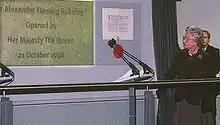
The Imperial Faculty of Medicine was formed through mergers between Imperial and the St Mary's, Charing Cross and Westminster, and Royal Postgraduate medical schools and has six teaching hospitals. It accepts more than 300 undergraduate medical students per year and has around 321 taught and 700 research full-time equivalent postgraduate students.
Imperial College Healthcare NHS Trust was formed on 1 October 2007 by the merger of Hammersmith Hospitals NHS Trust (Charing Cross Hospital, Hammersmith Hospital and Queen Charlotte's and Chelsea Hospital) and St Mary's NHS Trust (St. Mary's Hospital and Western Eye Hospital) with Imperial College London Faculty of Medicine.[143] It is an academic health science centre and manages five hospitals: Charing Cross Hospital, Queen Charlotte's and Chelsea Hospital, Hammersmith Hospital, St Mary's Hospital, and Western Eye Hospital. The Trust is currently one of the largest in the UK and in 2012/13 had a turnover of £971.3 million, employed approximately 9,770 people and treated almost 1.2 million patients.[144]
Other (non-academic health science centres) hospitals affiliated with Imperial College include Chelsea and Westminster Hospital, Royal Brompton Hospital, West Middlesex University Hospital, Hillingdon Hospital, Mount Vernon Hospital, Harefield Hospital, Ealing Hospital, Central Middlesex Hospital, Northwick Park Hospital, St Mark's Hospital, St Charles' Hospital and St Peter's Hospital.[145]
Controversies
Accusations of bullying
In 2003, it was reported that one third of female academics "believe that discrimination or bullying by managers has held back their careers".[146] Imperial has since won the Athena SWAN Award, which recognises employment practices that are supportive of the careers of women in science, technology, engineering and maths.
In 2007, concerns were raised about the methods that were being used to fire people in the Faculty of Medicine.[147][148] In 2014, Stefan Grimm, of the Department of Medicine, was found dead after being threatened with dismissal for failure to raise enough grant money.[149] His last email before his death accused his employers of bullying by demanding that he should get grants worth at least £200,000 per year.[150][151] The college announced an internal inquiry into Stefan Grimm's death, and found that the performance metrics for his position were unreasonable, with new metrics for performance being needed.[152]
The issue of bullying within the staff at Imperial resurfaced in November 2020 when Alex Sobel, the Labour MP for Leeds North West asked the Secretary of State for Education in a written question on 24 November what steps the Office for Students had taken in response to a report by Jane McNeill QC dated 25 August which found that bullying had taken place at Imperial under the President (Alice Gast) and the Chief Financial Officer. Michelle Donelan, the Conservative MP for Chippenham, responded for the Department for Education that "The Office for Students (OfS) is considering the information it has received in relation to this matter, in line with their normal processes. As is standard practice, the OfS cannot comment on individual cases".[153] The college was accused of a cover-up by the Universities and Colleges Union in December 2020 when it refused to publish McNeill's report, even in redacted form. The Chair of Council said that the report was kept confidential to preserve the anonymity of people who gave evidence, that its recommendations had been accepted by the senior leadership team, and that these recommendations were being implemented in full. A disciplinary panel decided that Gast's dismissal as president was not warranted and spokesperson for the college said that she had "offered wholehearted apologies to those affected".[154]
Student life
Student body
For the 2018/19 academic year, Imperial had a total full-time student body of 19,115, consisting of 9,985 undergraduate students and 9,130 postgraduates.[5] 50.7% of the student body is from outside of the UK.[155] 32% of all full-time students came from outside the European Union in 2013–14,[156] and around 13% of the International students had Chinese nationality in 2007–08.[157]
Imperial's male to female ratio for undergraduate students is uneven at approximately 64:36 overall[157] and 5:1 or higher in some engineering courses. However, medicine has an approximate 1:1 ratio with biology degrees tending to be higher.[158]
Imperial College Union
Imperial College Union is the students' union and is run by five full-time sabbatical officers elected from the student body for a tenure of one year, and a number of permanent members of staff. It is split into constituent unions aligned with the faculties of the college, carrying on the association with the original constituent colleges of Imperial, the Royal College of Science Union, City and Guilds College Union, Royal School of Mines Students' Union and Imperial College School of Medicine Students' Union. The Union is given a large subvention by the university, much of which is spent on maintaining over 300 clubs, projects and societies.[159] Examples of notable student groups and projects are Project Nepal which sends Imperial College students to work on educational development programmes in rural Nepal[160] and the El Salvador Project, a construction based project in Central America.[161] The Union also hosts sports-related clubs such as Imperial College Boat Club and Imperial College Gliding Club.
The Union operates on two sites, with most events at the Union Building on Beit Quad at South Kensington, with mostly medical school events at the Reynold's bar, Charing Cross.
Facilities
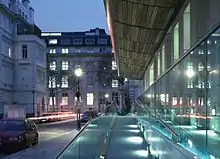
Sports facilities at Imperial's London campuses include four gyms, including the main Ethos gym at the South Kensington Campus, two swimming pools and two sports halls.[162] Imperial has additional sports facilities at the Heston and Harlington sports grounds.
On the South Kensington campus, there are a total of six music practice rooms which consist of upright pianos for usage by people of any grade, and grand pianos which are exclusively for people who have achieved Grade 8 or above.[163]
There are two student bars on the South Kensington campus, one at the Imperial College Union and one at Eastside.[164] There are a number of pubs and bars on campus and also surrounding the campus, which become a popular social activity for Imperial's students. The Pewter tankard collection at Imperial College Union is the largest in Europe, with the majority of clubs and societies having tankards associated with their clubs.[165]
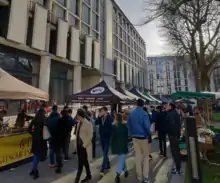
Imperial College Radio
Imperial College Radio (ICRadio) was founded in November 1975 with the intention of broadcasting to the student halls of residence from a studio under Southside, actually commencing broadcasts in late 1976. It now broadcasts from the West Basement of Beit Quad over the internet.[166]
Imperial College TV
Imperial College TV (ICTV) is Imperial College Union's TV station, founded in 1969 and operated from a small TV studio in the Electrical Engineering block. The department had bought an early AMPEX Type A 1-inch videotape recorder and this was used to produce an occasional short news programme which was then played to students by simply moving the VTR and a monitor into a common room. A cable link to the Southside halls of residence was laid in a tunnel under Exhibition Road in 1972. Besides the news, early productions included a film of the Queen opening what was then called College Block.
Felix Newspaper
Felix is weekly student newspaper, first released on 9 December 1949.[167] In addition to news, Felix also carries comic strips, features, opinions, puzzles and reviews, plus reports of trips and Imperial College sporting events.
Student societies

Imperial College Boat Club
The Imperial College Boat Club is the rowing club of Imperial and was founded on 12 December 1919. The college's boat house is located in Putney on the Thames, and was recently refurbished, reopening in 2014.[168] The club has a number of notable accolades, such as three alumni of the college in the gold medal winning GB 8+ at the 2000 Summer Olympic Games.
Sports
Imperial College has over 60 sports clubs,[169] of which many participate in the British Universities and Colleges Sport Association leagues such as American Football, Rugby, Badminton, Lacrosse, Football, Ice Hockey, and many others.[169]
Exploration Club
Imperial's Exploration Board was established in 1957 to assist students with a desire for exploration. Trips have included Afghanistan, Alaska, Cameroon, Ethiopia, Fiji, the Himalayas, Iran, Morocco, Norway, Tanzania, Thailand, Ukraine, and the Yukon.[170]
Dramatic Society
The Imperial College Dramatic Society (DramSoc[171]) is one of two major theatrical arts societies, with the other being the Musical Theatre Society, and it was founded in 1912.[172] The society puts on three major plays each year, in addition to several smaller fringe productions. It is additionally one the London-based dramatic societies to participate in the London Student Drama Festival,[173] and regularly attends the Edinburgh Fringe. DramSoc is responsible for the day-to-day maintenance of the Union's theatrical space, the Union Concert Hall.
The Techtonics
The Techtonics are an all-male a cappella group from Imperial College London, and are a part of the Imperial College A Cappella Society.[174] The group was formed in 2008, and has since risen to prominence in the world a cappella scene. The group is best known for winning the International Championship of Collegiate A Cappella in 2016.[175]
Student housing
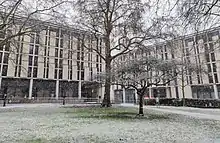
Imperial College owns and manages twenty-three halls of residence in Inner London, Acton, and Ascot. Over three thousand rooms are available, guaranteeing first year undergraduates a place in College residences.
The majority of halls offer single or twin accommodation with some rooms having en suite facilities. Bedrooms are provided with basic furniture and with access to shared kitchens and bathrooms. All rooms come with internet access and access to the Imperial network.[176] Most of them are considered among the newest student halls at London universities.
Most students in college or university accommodation are first-year undergraduates, as they are granted a room once they have selected Imperial as their firm offer with UCAS. The majority of older students and postgraduates find accommodation in the private sector, help for which is provided by the college private housing office. However a handful of students may continue to live in halls in later years if they take the position of a "hall senior", and places are available for a small number of returning students in the Evelyn Garden halls.[177] Some students also live in International Students House, London.
Notable alumni, faculty and staff
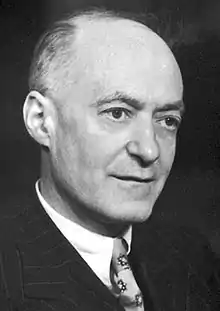
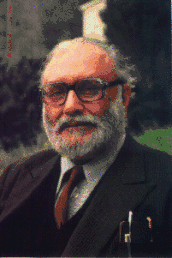
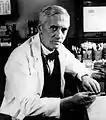

 Sir William Crookes
Sir William Crookes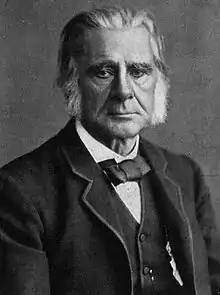
 Sir John Pendry
Sir John Pendry H.G. Wells
H.G. Wells.jpg.webp)
 Dame Sally Davies
Dame Sally Davies Brian May CBE
Brian May CBE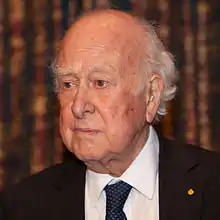
.jpg.webp)
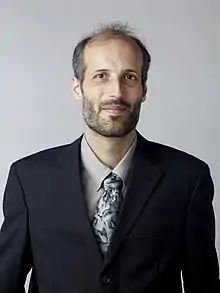 Sir Martin Hairer
Sir Martin Hairer
Nobel laureates: (medicine) Sir Alexander Fleming, Sir Ernst Boris Chain, Sir Frederick Gowland Hopkins, Sir Andrew Fielding Huxley, Rodney Robert Porter, (physics) Abdus Salam, Sir George Paget Thomson, Patrick Blackett, Baron Blackett, Dennis Gabor, Peter Higgs, (chemistry) Sir Norman Haworth, Sir Cyril Norman Hinshelwood, Sir Derek Barton, Sir Geoffrey Wilkinson, Sir George Porter.[178]
Fields medalists: Klaus Friedrich Roth, Sir Simon Donaldson, Martin Hairer.[179]
Academic affiliations include: Sir Tom Kibble, co-discoverer of Higgs Boson;[180] Sir Tejinder Virdee, experimental particle physicist;[181] Sir John Pendry, theoretical solid state physicist;[182] Sir Christopher Kelk Ingold, physical organic chemistry pioneer;[183] Sir William Henry Perkin, discoverer of the first synthetic organic chemical dye mauveine;[184] Sir Edward Frankland, originator of the theory of chemical valency;[185] Sir William Crookes, discoverer of thallium;[186] Sir Alan Fersht, chemist;[187] David Phillips, chemist;[188] Harold Hopkins, contributed to the theory and design of optical instruments;[189] Alfred North Whitehead, mathematician and philosopher;[190] Sir Steven Cowley, physicist and president of Corpus Christi College, Oxford;[191] and Sir John Ambrose Fleming, inventor of the vacuum tube.[192]
In biology and medicine; Thomas Huxley, advocate of the theory of evolution; Wendy Barclay, virologist; Dame Sally Davies, the Chief Medical Officer for England;[193] David Livingstone, medical missionary and Clare Lloyd, biologist. In engineering; Chi Onwurah, politician;[194] Dame Julia Higgins, polymer scientist;[195] Dame Judith Hackitt, former Chair of the Health and Safety Executive;[196] Dudley Maurice Newitt, scientific director of the Special Operations Executive;[197] and Julia King, Baroness Brown of Cambridge, engineer and Member of the House of Lords.[198]
Non-academic affiliations include: H. G. Wells, author;[199] Nikolas Tombazis, chief car designer at McLaren and Ferrari; Ralph Robins, CEO of Rolls-Royce;[200] Brian May, guitarist of rock band Queen;[201] Chew Choon Seng, CEO of Singapore Airlines; Sir Julius Vogel, former Prime Minister of New Zealand;[202] Rajiv Gandhi, Prime Minister of India;[203] Teo Chee Hean, Deputy Prime Minister of Singapore;Edem Tengue,Minister of maritime economy of the republic of Togo; Huw Thomas, Physician to the Queen;[204] Sir Roger Bannister, ran the first four-minute mile;[205] David Warren, inventor of the flight data recorder and cockpit voice recorder;[206] Andreas Mogensen, first Danish astronaut; David Pearson, software engineer; Winston Wong, entrepreneur; Alan Howard, hedge fund manager and philanthropist; Cyrus Pallonji Mistry, former chairman of the Tata Group;[207] Michael Birch, entrepreneur; Henry Charles Stephens, politician; Sir Michael Uren, businessman and philanthropist; Ian Read, CEO of Pfizer, Pallab Ghosh, BBC correspondent, Hannah Devlin, science journalist; Edwin Samuel Crump, designed of the Crump weir.
See also
Notes
- The motto and coat of arms were granted to Imperial College by Royal Warrant in 1908. On 5 June 2020 Imperial announced that it would no longer use the motto on the crest.[1]
References
- "The College crest". Imperial College London. Retrieved 5 June 2019.
- "Charitable status". Imperial College London. Retrieved 4 June 2020.
- "Annual Report and Accounts 2019–20" (PDF). Imperial College London. Retrieved 21 January 2020.
- "Who's working in HE". Higher Education Statistics Agency. Staff numbers by HE provider. Retrieved 1 March 2020.
- "Where do HE students study?". Higher Education Statistics Agency. Retrieved 1 March 2020.
- "Brand colours". Imperial College London. Retrieved 28 November 2018.
- "Imperial College of Science, Technology and Medicine – Charter" (PDF). Imperial College London.
- "Prince Albert's cultural vision and the history of South Kensington: What is Albertopolis?". Royal Albert Hall. Retrieved 3 January 2019.
- "Chemistry at Imperial". Imperial College London. Retrieved 24 December 2018.
- "City and Guilds College ─ Imperial College". architecture.com. Royal Institute of British Architects. Archived from the original on 2 October 2012.
- University of London, the Historical Record. University of London Press. 1912. p. 85.
- "Imperial College splits from University of London". The Guardian. 5 October 2006. Retrieved 27 November 2015.
- "Most international universities in the world 2018: top 200". Times Higher Education. 14 March 2018.
- "International students | Study". Imperial College London. Retrieved 12 December 2018.
- "Award winners | Imperial College London". imperial.ac.uk. Retrieved 10 March 2015.
- "Royal School of Mines – Imperial College". architecture.com. Royal Institute of British Architects. Archived from the original on 15 September 2012.
- "A timeline of College developments". imperial.ac.uk. Imperial College London. Retrieved 27 December 2018.
- Ballantyne, John (August 2004). "St Mary's: the History of a London Teaching Hospital". Journal of the Royal Society of Medicine. 97 (8): 405–406. doi:10.1258/jrsm.97.8.405-a. ISSN 0141-0768. PMC 1079568.
- "Lost Hospitals of London". ezitis.myzen.co.uk. Retrieved 27 December 2018.
- "Albertopolis – the wisdom of Prince Albert". chr.org.uk. Cultural Heritage Resources. Retrieved 24 December 2018.
- "Imperial College". british-history.ac.uk. British History Online. Retrieved 24 December 2018.
- "Royal College of Science ─ Imperial College". architecture.com. Royal Institute of British Architects. Archived from the original on 2 October 2012.
- The Oxford Dictionary of Abbreviations. 1992. ISBN 9780192800732.
- F. H. W. Sheppard, ed. (1975). Imperial College. Survey of London: Volume 38, South Kensington Museums Area. London County Council. pp. 233–247 – via british-history.ac.uk.
- The Report of the Board of Education to the King's Most Excellent Majesty in Council for the Year 1905–1906. HMSO. 1906. pp. 16–17.
- "Imperial College of Science and Technology". Nature. 76 (1959): 56–57. 16 May 1907. Bibcode:1907Natur..76...56.. doi:10.1038/076056a0.
- "The London Imperial College of Science and Technology". Science. XLIX (1261): 209–210. 28 February 1919. Bibcode:1919Sci....49..209.. doi:10.1126/science.49.1261.209.
- "The Imperial College of Science and Technology". Nature. 105 (2632): 173–175. 16 May 1907. doi:10.1038/105173a0.
- "Imperial College 1920–1929". Imperial College. Retrieved 21 January 2019.
- "Imperial College 1940–1949". Imperial College. Retrieved 21 January 2019.
- "Imperial celebrates its newest graduates at Commemoration Day 2018". Imperial College. Retrieved 21 January 2019.
- Gay, Hannah (2007). The History of Imperial College London, 1907–2007: Higher Education and Research in Science, Technology, and Medicine. World Scientific. ISBN 9781860947087.
- Jean Bocock; Lewis Baston; Peter Scott; David Smith (2003). "American influence on British higher education: science, technology, and the problem of university expansion, 1945–1963". Minerva. 41 (4): 327–346. doi:10.1023/B:MINE.0000005154.25610.b2. JSTOR 41821255. S2CID 143347639.
- Michael Shattock (1 October 2012). Making Policy in British Higher Education 1945-2011. McGraw-Hill Education (UK). ISBN 9780335241873.
- "Higher Technological Education (Government Policy)". Hansard. 11 June 1952. Retrieved 22 January 2019.
- John Boyd-Carpenter (29 January 1953). "Imperial College Of Science And Technology (Expansion)". Hansard.
- J S Cockburn; H P F King; K G T McDonnell, eds. (1969). "The University of London: The Constituent Colleges". The Imperial College of Science and Technology. A History of the County of Middlesex: Volume 1, Physique, Archaeology, Domesday, Ecclesiastical Organization, the Jews, Religious Houses, Education of Working Classes To 1870, Private Education From Sixteenth Century. Victoria County History. pp. 345–359 – via British History Online.
- "The Queen's Tower". Imperial College. Retrieved 29 January 2019.
- "The Wolfson Foundation 1955–2015: Sixty Years of Philanthropy" (PDF). The Wolfson Foundation. 2015. pp. 29, 57. Archived from the original (PDF) on 2 February 2017. Retrieved 17 July 2016.
- "Imperial College – Centenary website – Timeline – 1960–1969". www.imperial.ac.uk. Retrieved 19 December 2016.
- "Charter and Statutes" (PDF). Imperial College. Explanatory note. Retrieved 2 February 2019.
- "WEST LONDON MEDICINE – PAST AND FUTURE". Imperial College London. Retrieved 24 June 2018.
- "A timeline of College Developments". Imperial College London.
- "New identity for Imperial College Business School". Imperial College London. Retrieved 20 June 2017.
- "Imperial College London – Imperial College London to begin negotiations to withdraw from the University of London". Imperial.ac.uk. 9 December 2005. Retrieved 16 June 2011.
- "Imperial College top choice for Singaporean students". Comp.nus.edu.sg. Archived from the original on 11 June 2011. Retrieved 23 March 2011.
- "University of London: Updated position statement re: Imperial College London". London.ac.uk. Archived from the original on 10 December 2006. Retrieved 16 June 2011.
- "Imperial launches its new hub for innovation at White City". Imperial News. Imperial College London. Retrieved 4 April 2019.
- Djaba, Andy. "White City Woes". felixonline.co.uk. Archived from the original on 1 December 2018. Retrieved 24 December 2018.
- "Sir Michael Uren, engineer who poured vast sums into charitable projects from a fortune built on recycling steel-industry slag – obituary". The Daily Telegraph. 17 September 2019. Archived from the original on 31 May 2020. Retrieved 31 May 2020.
- "MIT expands partnership with Imperial College London". MIT News. Retrieved 12 May 2018.
- "London's top tourist attractions see visitor numbers fall". 16 March 2018.
- "Food and drink". Imperial College London.
- "IC Tennis – Imperial College Lawn Tennis Club". 28 August 2018.
- Barrett, Claer (5 August 2014), Imperial unveils details of £3bn campus extension – via Financial Times
- "Novartis joins rush of science companies moving to White City". Evening Standard. 28 November 2018. Retrieved 24 December 2018.
- Fyles, Fred S. "College reaches out to White City community with Invention Rooms". felixonline.co.uk. Archived from the original on 24 December 2018. Retrieved 24 December 2018.
- "Open Cell launches affordable biotech hub in Shepherds Bush". Hammersmith & Fulham Council. 31 July 2018. Retrieved 31 July 2019.
- "Imperial White City Incubator". Imperial College London. Retrieved 27 February 2020.
- "St Mary's Fleming Library". Imperial College London. Retrieved 26 December 2018.
- "Faculties and departments". Imperial College London. Retrieved 21 April 2018.
- "Evening classes and lunchtime learning". Imperial College London. Retrieved 2 September 2019.
- Past Rectors, Imperial College London, retrieved 21 March 2009
- "Professor Alice Gast to become sixteenth head and first woman to lead Imperial | Imperial News | Imperial College London". Imperial News.
- "James Stirling to be Imperial's first Provost". Imperial College London. 12 December 2012. Retrieved 14 January 2013.
- "Composition and Membership". Imperial College London. Retrieved 14 January 2018.
- "Annual Report and Accounts 2018–19" (PDF). Imperial College London. Retrieved 24 December 2019.
- "Imperial College and 'M.I.T.'". Nature. 153 (3873): 104. 1 January 1944. Bibcode:1944Natur.153R.104.. doi:10.1038/153104b0. ISSN 1476-4687.
- "MIT expands partnership with Imperial College London". MIT News. Retrieved 21 March 2018.
- "MIT and Imperial launch 'unparalleled' student exchange | Imperial News | Imperial College London". Imperial News. Retrieved 21 March 2018.
- "University League Table 2021". The Complete University Guide. 1 June 2020.
- "University league tables 2021". The Guardian. 5 September 2020.
- "The Times and Sunday Times University Good University Guide 2021". Times Newspapers.
- "Academic Ranking of World Universities 2020". Shanghai Ranking Consultancy.
- "CWTS Leiden Ranking 2020 - PP top 10%". CWTS Leiden Ranking 2020.
- "QS World University Rankings 2021". Quacquarelli Symonds Ltd.
- "World University Rankings 2021". Times Higher Education.
- "Teaching Excellence Framework outcomes". Higher Education Funding Council for England.
- "World University Rankings 2021". Times Higher Education. Retrieved 11 September 2020.
- "Best universities in Europe". Times Higher Education (THE). 21 November 2018. Retrieved 5 June 2019.
- "World University Rankings 2019 by subject: clinical, pre-clinical and health". Times Higher Education. Retrieved 24 May 2019.
- "World University Rankings 2019 by subject: physical sciences". Times Higher Education. Retrieved 24 May 2019.
- "World University Rankings 2019 by subject: computer science". Times Higher Education. Retrieved 24 May 2019.
- "World University Rankings 2019 by subject: engineering and technology". Times Higher Education. Retrieved 24 May 2019.
- "World University Rankings 2019 by subject: life sciences". Times Higher Education. Retrieved 24 May 2019.
- "QS World University Rankings 2021". Top Universities. Retrieved 9 June 2020.
- "Top Universities in Europe | US News Best Global Universities". Usnews.com. 28 October 2014. Retrieved 10 March 2015.
- Ellie Bothwell (7 October 2020). "THE 'Table of Tables' 2021: Scottish universities make gains". Times Higher Education.
- "Imperial College London". thecompleteuniversityguide.co.uk. Retrieved 9 June 2020.
- "Reuters". Reuters. 11 October 2018.
- "MBA by Specialization – Entrepreneurship 2019". TopMBA.com. 15 March 2019. Retrieved 27 March 2019.
- "Career University Guide". Career Prospects. Archived from the original on 24 June 2016. Retrieved 19 May 2016.
- "Top UK University League Tables and Rankings 2020". thecompleteuniversityguide.co.uk. Retrieved 22 May 2019.
- DeNisco Rayome, Alison (17 September 2018). "Computer science graduates make more money than anyone else in the UK". TechRepublic. Retrieved 7 February 2021.
- Collinson, Patrick (23 September 2018). "Graduates of Imperial College beat Oxbridge on earnings". The Guardian. ISSN 0261-3077. Retrieved 22 May 2019.
- "Undergraduate degrees: relative labour market returns (Table 7: HEI – conditional impact on earnings five years after graduation)". Department for Education. Retrieved 17 December 2018.
- Kirk, Ashley; Scott, Patrick (14 August 2019). "Britain's highest paying degrees, according to UK graduate salaries". The Telegraph. ISSN 0307-1235. Retrieved 5 October 2019.
- "What the job market wants". The New York Times. 25 October 2012. Retrieved 7 February 2013.
- "REF 2014 winners: who performed best?". Times Higher Education. 18 December 2014. Retrieved 5 April 2015.
- "Results". Imperial College London. Retrieved 19 May 2018.
- "Overall ranking of institutions including power market share". Times Higher Education. 18 December 2014. Retrieved 5 April 2015.
- "Imperial College London – Fleming's early research is honoured". imperial.ac.uk. 1999. Retrieved 29 November 2019.
- Goff, David (8 October 2013). Fiber Optic Video Transmission: The Complete Guide. CRC Press. p. 22. ISBN 978-1-136-02490-0.
- Beléndez, Augusto (5 June 2015). "Dennis Gabor, "Father of Holography"". OpenMind. Retrieved 29 November 2019.
- "Background to the Group – Imperial Innovations". Archived from the original on 31 July 2016.
- "How Imperial College is turning innovation into cash". 30 November 2015. Archived from the original on 20 August 2018. Retrieved 17 July 2016.
- "USA and Canada | About | Imperial College London". imperial.ac.uk. Retrieved 29 November 2019.
- "Imperial College London and CNRS create joint laboratory to bring world's best mathematicians together". www2.cnrs.fr (in French). Retrieved 17 May 2018.
- "Fields Medal winners launch new mathematics laboratory". Imperial News. Imperial College London. Retrieved 17 May 2018.
- "CNRS and Imperial College London expand partnership". CNRS. 9 June 2020. Retrieved 7 July 2020.
- "Imperial and France's CNRS expand partnership with joint PhDs and data projects". Imperial News. 9 June 2020. Retrieved 7 July 2020.
- "Imperial College and France's CNRS launch joint PhD programme in Mathematical Sciences". Ambassade de France au Royaume-Uni. 27 January 2020. Retrieved 7 July 2020.
- "CRUK Imperial Center Website". crukimperialcentre.co.uk. Archived from the original on 26 May 2020. Retrieved 29 November 2019.
- "Joe Biden delivers inaugural cancer research lecture at Imperial". Imperial News. Imperial College London. Retrieved 29 November 2019.
- W. Bruce Banerdt (6 October 2016). "InSight Status Report" (PDF). Jet Propulsion Laboratory. Retrieved 29 November 2019.
- mars.nasa.gov. "Sol 26: Instrument Deployment Camera (IDC)". NASA's InSight Mars Lander. Retrieved 29 November 2019.
- Bartels, Meghan. "Marsquake! NASA's InSight Lander Feels Its 1st Red Planet Tremor". Space.com. Retrieved 29 November 2019.
- "First 'Marsquake' captured by UK sensors | University of Oxford". ox.ac.uk. Retrieved 29 November 2019.
- Imperial College. "Marsquake sensor lands safely on Red Planet | Imperial News | Imperial College London". Imperial News. Retrieved 29 November 2019.
- "Solar Orbiter spacecraft heads to launch site on its way to the Sun | Imperial News | Imperial College London". Imperial News. Retrieved 29 November 2019.
- Amy Thompson. "Solar Orbiter launches on historic mission to study the sun's poles". Space.com. Retrieved 4 April 2020.
- "Imperial among UK institutions building parts for new £30m neutrino detector | Imperial News | Imperial College London". Imperial News. November 2019. Retrieved 29 November 2019.
- "Coronavirus: 'Significant breakthrough' in race for vaccine made by UK scientists". Sky News. Retrieved 6 February 2020.
- "Imperial researchers in race to develop a coronavirus vaccine | Imperial News | Imperial College London". Imperial News. Retrieved 6 February 2020.
- "U.K. Lab to Sidestep Drug Industry to Sell Potential Virus Vaccine". New York Times. Retrieved 7 June 2020.
- "Coronavirus vaccine trial by Imperial College London begins". The Guardian. Guardian staff and agencies. 16 June 2020. Retrieved 20 June 2020.
- Ferguson, Neil M; Laydon, Daniel; Nedjati-Gilani, Gemma; Imai, Natsuko; Ainslie, Kylie; Baguelin, Marc; Bhatia, Sangeeta; Boonyasiri, Adhiratha; Cucunubá, Zulma; Cuomo-Dannenburg, Gina; Dighe, Amy; Fu, Han; Gaythorpe, Katy; Thompson, Hayley; Verity, Robert; Volz, Erik; Wang, Haowei; Wang, Yuanrong; Walker, Patrick GT; Walters, Caroline; Winskill, Peter; Whittaker, Charles; Donnelly, Christl A; Riley, Steven; Ghani, Azra C (16 March 2020). "Impact of non-pharmaceutical interventions (NPIs) to reduce COVID-19 mortality and healthcare demand" (PDF). Imperial College of Science, Technology and Medicine: 20. Retrieved 22 March 2020.
- Landler, Mark; Castle, Stephen. "Behind the Virus Report That Jarred the U.S. and the U.K. to Action – The New York Times". Retrieved 22 March 2020.
- "Amid Ongoing COVID-19 Pandemic, Governor Cuomo Announces State is Bringing in International Experts to Help Advise the State's Reopening Plan". New York State. Retrieved 20 May 2020.
- "Imperial College Healthcare NHS Trust uses Microsoft HoloLens to protect doctors while providing patient care amid coronavirus pandemic". Microsoft. Microsoft. Retrieved 20 May 2020.
- "2020 entry provider-level end of cycle data resources". UCAS. 2021. I50 Imperial College London. Retrieved 6 February 2021.
- "2020 entry UCAS undergraduate reports by sex, area background, and ethnic group". UCAS. 2021. I50 Imperial College. Retrieved 6 February 2021.
- "Top UK University League Table and Rankings". Complete University Guide. Retrieved 6 February 2021.
- "Statistics Pocket Guide 2019–20" (PDF). Imperial College London. 2020. Retrieved 2 December 2020.
- "Statistics Pocket Guide 2018–19" (PDF). Imperial College London. 2019. Retrieved 6 November 2019.
- "University League Tables 2020". Complete University Guide. Retrieved 1 March 2020.
- "Most international universities in the world 2018: top 200". Times Higher Education (THE). 14 March 2018. Retrieved 19 March 2018.
- "Widening participation: UK Performance Indicators 2016/17". hesa.ac.uk. Higher Education Statistics Authority. Retrieved 1 February 2018.
- "The World's Most International Universities 2017". Times Higher Education (THE). 1 February 2017. Retrieved 10 February 2018.
- "Where do HE students study?". hesa.ac.uk. Higher Education Statistics Authority. Retrieved 9 February 2018.
- "Science Museum Library closes to prepare for new research centre". Imperial News. Imperial College London. Retrieved 25 December 2018.
- "Our libraries". imperial.ac.uk. Imperial College London. Retrieved 25 December 2018.
- "About us – Imperial College Healthcare NHS Trust Internet". Imperial.nhs.uk. Retrieved 23 March 2011.
- "Annual Report 2012/13" (PDF). Imperial College Healthcare NHS Trust. Archived from the original (PDF) on 22 December 2014. Retrieved 28 April 2013.
- "Meet the Council". Chelsea and Westminster NHS Foundation Trust. Archived from the original on 6 July 2009. Retrieved 14 September 2009.
- Woodward, Will; Editor, Education (18 April 2003). "Female staff 'feel bullied' at Imperial College". The Guardian. Retrieved 6 December 2014.CS1 maint: extra text: authors list (link)
- "Crude recipe for a 'chicken-run' sector". 31 May 2007. Retrieved 6 December 2014.
- Colquhoun, David (2007). "How to get good science" (PDF). Physiology News. 69: 12–14.
- "Imperial College London to 'review procedures' after death of academic". 27 November 2014. Retrieved 6 December 2014.
- "Publish and perish at Imperial College London: the death of Stefan Grimm". December 2014. Retrieved 6 December 2014.
- "Imperial College professor Stefan Grimm 'was given grant income target'". 3 December 2014. Retrieved 6 December 2014.
- "Stefan Grimm inquest: new policies may not have prevented suicide". Times Higher Education (THE). 9 April 2015. Retrieved 23 January 2017.
- "Bullying: Imperial College London. Question for Department for Education". 24 November 2020. Retrieved 4 December 2020.
- Quinn, Ben (7 December 2020). "Imperial College accused of cover-up over claims of bullying by president". The Guardian. Retrieved 7 December 2020.
- "World-ranked universities with the most international students". Times Higher Education. Retrieved 30 September 2015.
- "2013/14 Students by HE provider, level, mode and domicile". Higher Education Statistics Agency. Archived from the original (XLSX) on 3 March 2016. Retrieved 8 November 2015.
- "Statistics Pocket Guide 2009–10" (PDF). Imperial College London. Archived from the original (PDF) on 10 August 2011. Retrieved 16 August 2013.
- "Search best UK universities, make university comparisons and see student satisfaction ratings and UCAS points". Unistats. Retrieved 23 March 2011.
- Dave Parry. "Imperial College Union". Union.ic.ac.uk. Archived from the original on 30 April 2006. Retrieved 16 June 2011.
- "Felix : The student voice of Imperial College London" (PDF). Felixonline.co.uk. Archived from the original (PDF) on 4 March 2016. Retrieved 10 March 2015.
- "Sponsors". Elsalvadorproject.org.uk. Archived from the original on 4 March 2016. Retrieved 10 March 2015.
- Imperial College London. "Imperial College Sports Facilities". imperial.ac.uk. Retrieved 21 March 2012.
- Imperial College London. "Imperial College Music Facilities". imperial.ac.uk. Retrieved 21 March 2012.
- Imperial College Union. "Food and Drink". imperialcollegeunion.org. Retrieved 21 March 2012.
- "Questions about Tankards". Archived from the original on 23 May 2017.
- "Imperial College Radio, London, UK". Icradio.com. Archived from the original on 5 July 2020. Retrieved 16 June 2011.
- "Imperial College – Centenary website – Timeline – 1940–1949". ic.ac.uk.
- "Putney Boathouse development". Imperial College London. Retrieved 25 December 2018.
- "Imperial College Union A to Z of Societies". Imperial College Union. Retrieved 24 February 2020.
- "Exploration Club". A timeline of College Developments.
- "DramSoc". DramSoc. Retrieved 25 December 2018.
- "Dramatic Changes" (371). Felix Newspaper. 9 December 1974. Archived from the original on 14 March 2015. Retrieved 28 June 2015.
- "London Student Drama Festival". UCLU Drama. UCLU Drama Society. Archived from the original on 1 July 2015. Retrieved 28 June 2015.
- "Imperial A Cappella Society". Imperial College Union. Retrieved 3 June 2020.
- "Results". Varsity Vocals. Retrieved 3 June 2020.
- "College Accommodation Licence (2019–2020)" (PDF).
- "Accommodation for returning students".
- "Award winners | Imperial College London". Imperial.ac.uk. Retrieved 10 March 2015.
- "Fields medallists". Imperial College London. Retrieved 13 July 2018.
- ‘KIBBLE, Sir Thomas (Walter Bannerman)’, Who Was Who, A & C Black, an imprint of Bloomsbury Publishing plc, 1920–2016; online edn, Oxford University Press, 2016 ; online edn, Nov 2016 accessed 2 April 2017
- ‘VIRDEE, Sir Tejinder Singh’, Who's Who 2017, A & C Black, an imprint of Bloomsbury Publishing plc, 2017; online edn, Oxford University Press, 2016 ; online edn, Nov 2016 accessed 2 April 2017
- ‘PENDRY, Sir John (Brian)’, Who's Who 2017, A & C Black, an imprint of Bloomsbury Publishing plc, 2017; online edn, Oxford University Press, 2016 ; online edn, Nov 2016 accessed 2 April 2017
- ‘INGOLD, Sir Christopher (Keik)’, Who Was Who, A & C Black, an imprint of Bloomsbury Publishing plc, 1920–2016; online edn, Oxford University Press, 2014 ; online edn, April 2014 accessed 2 April 2017
- ‘PERKIN, Sir William Henry’, Who Was Who, A & C Black, an imprint of Bloomsbury Publishing plc, 1920–2016; online edn, Oxford University Press, 2015 ; online edn, Feb 2015 accessed 2 April 2017
- ‘FRANKLAND, Sir Edward’, Who Was Who, A & C Black, an imprint of Bloomsbury Publishing plc, 1920–2016; online edn, Oxford University Press, 2014 ; online edn, April 2014 accessed 2 April 2017
- ‘CROOKES, Prof. Sir William’, Who Was Who, A & C Black, an imprint of Bloomsbury Publishing plc, 1920–2016; online edn, Oxford University Press, 2014 ; online edn, April 2014 accessed 2 April 2017
- "Fersht, Sir Alan (Roy), (born 21 April 1943), Herchel Smith Professor of Organic Chemistry, University of Cambridge, 1988–2010; Fellow, since 1988, and Master, 2012–18, Gonville and Caius College, Cambridge; Hon. Director, Cambridge Centre for Protein Engineering (formerly MRC Unit for Protein Function and Design), 1989–2010; Emeritus Group Leader, MRC Laboratory of Molecular Biology, Cambridge, since 2010". Who's Who. Oxford University Press. 1 December 2018. doi:10.1093/ww/9780199540884.013.U15668.
- "Phillips, Prof. David, (born 3 Dec. 1939), Professor of Physical Chemistry, 1989–2006, Hofmann Professor of Chemistry, 1999–2006, now Professor Emeritus, and Dean, Faculties of Life Sciences and Physical Sciences, 2002–06, Imperial College London". Who's Who. Oxford University Press. 1 December 2018. doi:10.1093/ww/9780199540884.013.U30743.
- ‘HOPKINS, Prof. Harold Horace’, Who Was Who, A & C Black, an imprint of Bloomsbury Publishing plc, 1920–2016; online edn, Oxford University Press, 2014 ; online edn, April 2014 accessed 2 April 2017
- ‘WHITEHEAD, Alfred North’, Who Was Who, A & C Black, an imprint of Bloomsbury Publishing plc, 1920–2016; online edn, Oxford University Press, 2014 ; online edn, April 2014 accessed 2 April 2017
- ‘COWLEY, Prof. Steven’, Who's Who 2017, A & C Black, an imprint of Bloomsbury Publishing plc, 2017; online edn, Oxford University Press, 2016 ; online edn, Nov 2016 accessed 2 April 2017
- ‘FLEMING, Sir (John) Ambrose’, Who Was Who, A & C Black, an imprint of Bloomsbury Publishing plc, 1920–2016; online edn, Oxford University Press, 2014 ; online edn, April 2014 accessed 2 April 2017
- Davies, Dame Sally (Claire), WHO'S WHO & WHO WAS WHO. Retrieved 27 December 2017, from http://www.ukwhoswho.com/view/10.1093/ww/9780199540884.001.0001/ww-9780199540884-e-13126.
- "MP Chi Onwurah: "As an engineer, I was often the only Black person in the room" | Imperial News | Imperial College London". Imperial News. Retrieved 10 November 2018.
- Higgins, Dame Julia (Stretton), WHO'S WHO & WHO WAS WHO. Retrieved 27 December 2017, from http://www.ukwhoswho.com/view/10.1093/ww/9780199540884.001.0001/ww-9780199540884-e-20092.
- Hackitt, Dame Judith (Elizabeth), WHO'S WHO & WHO WAS WHO. Retrieved 27 December 2017, from http://www.ukwhoswho.com/view/10.1093/ww/9780199540884.001.0001/ww-9780199540884-e-151505.
- Newitt, Dudley Maurice, WHO'S WHO & WHO WAS WHO. Retrieved 27 December 2017, from http://www.ukwhoswho.com/view/10.1093/ww/9780199540891.001.0001/ww-9780199540884-e-157958.
- Brown of Cambridge, Baroness, (Julia Elizabeth King), WHO'S WHO & WHO WAS WHO. Retrieved 27 December 2017, from http://www.ukwhoswho.com/view/10.1093/ww/9780199540884.001.0001/ww-9780199540884-e-41612.
- Parrinder, Patrick (6 January 2011). "Wells, Herbert George (1866–1946), novelist and social commentator". Oxford Dictionary of National Biography. Oxford Dictionary of National Biography (online ed.). Oxford University Press. doi:10.1093/ref:odnb/36831. (Subscription or UK public library membership required.)
- ‘ROBINS, Sir Ralph (Harry)’, Who's Who 2017, A & C Black, an imprint of Bloomsbury Publishing plc, 2017; online edn, Oxford University Press, 2016 ; online edn, Nov 2016 accessed 2 April 2017
- ‘MAY, Dr Brian Harold’, Who's Who 2017, A & C Black, an imprint of Bloomsbury Publishing plc, 2017; online edn, Oxford University Press, 2016 ; online edn, Nov 2016 accessed 2 April 2017
- ‘VOGEL, Hon. Sir Julius’, Who Was Who, A & C Black, an imprint of Bloomsbury Publishing plc, 1920–2016; online edn, Oxford University Press, 2014 ; online edn, April 2014 accessed 2 April 2017
- ‘GANDHI, Rajiv’, Who Was Who, A & C Black, an imprint of Bloomsbury Publishing plc, 1920–2016; online edn, Oxford University Press, 2014 ; online edn, April 2014 accessed 2 April 2017
- ‘THOMAS, Prof. Huw Jeremy Wyndham’, Who's Who 2017, A & C Black, an imprint of Bloomsbury Publishing plc, 2017; online edn, Oxford University Press, 2016 ; online edn, Nov 2016 accessed 2 April 2017
- ‘BANNISTER, Sir Roger (Gilbert)’, Who's Who 2017, A & C Black, an imprint of Bloomsbury Publishing plc, 2017; online edn, Oxford University Press, 2016 ; online edn, Nov 2016 accessed 2 April 2017
- "This little-known inventor has probably saved your life". BBC News.
- ‘MISTRY, Cyrus Pallonji’, Who's Who 2017, A & C Black, an imprint of Bloomsbury Publishing plc, 2017; online edn, Oxford University Press, 2016 ; online edn, Nov 2016 accessed 2 April 2017
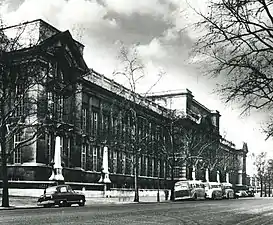
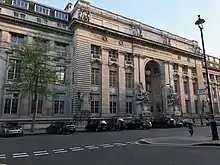

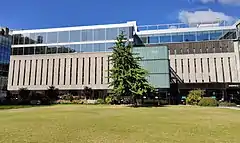

.JPG.webp)
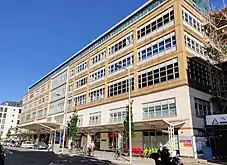
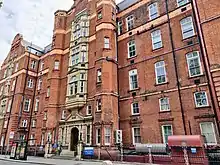
.JPG.webp)

